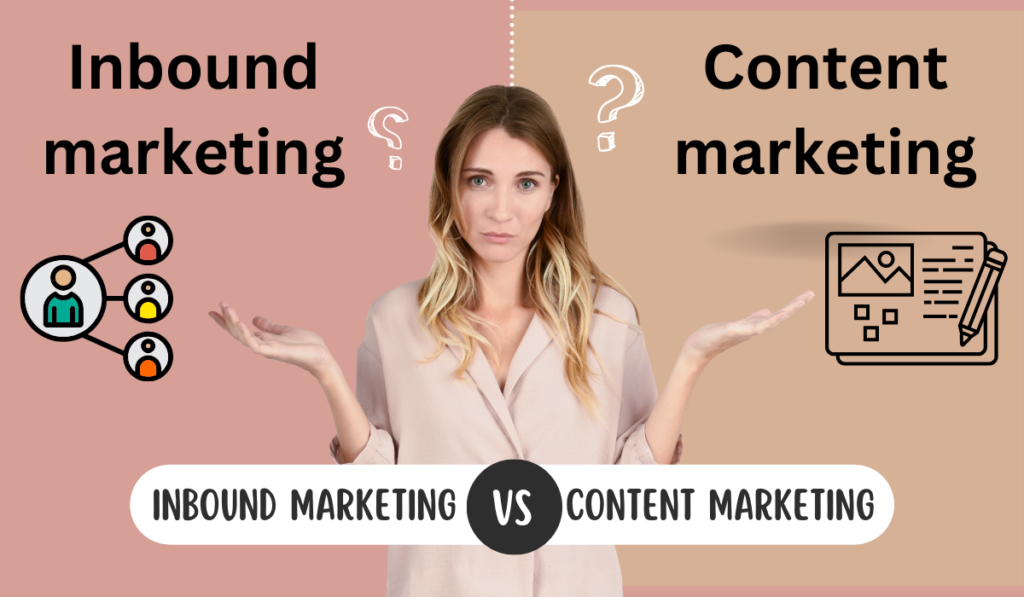Inbound marketing and content marketing are two terms that people use most often as synonyms although these two are not the same. Both of these are important in the context of digital marketing but are not equivalent, everyone has their function and approach. This article covers working, definitions, differences, benefits and concepts between inbound marketing vs content marketing.
What is Inbound Marketing?
Inbound marketing is a long-term strategy that focuses on attracting and engaging target audiences with valuable content, unlike intrusive advertisements. This approach aims to convert leads into loyal customers.
Key Principles of Inbound Marketing:
Attract: Promote your website with the help of SEO techniques, blog, social networks and many others tools to interest potential consumers.
Engage: Create a meaningful relationship with your audience by offering value in the form of content, newsletters, and engaging activities.
Delight: Provide customer service, maintain customer relations, and non-stop provide useful information to convert customers into brand advocates.
Inbound marketing, unlike traditional methods, focuses on building trust and value, turning visitors into loyal customers and promoters.
What is Content Marketing?
Content marketing is a strategic marketing method that enables the creation and distribution of content for the targeted audiences that are specific, useful, interesting, and frequent. It focuses on achieving profitable customer actions with target market content needs while building brand authority.
Types of Content Used in Content Marketing:
- Blog Posts and Articles: Knowledge centered materials that reply to queries and present useful information.
- Ebooks and Whitepapers: Sources that provide an extensive coverage of a subject, affording a number of particulars relating to it.
- Infographics: Infographics that help to decode information and data by presenting this information in a straightforward and clear way.
- Videos and Webinars: Engaging formats for delivering valuable information and capturing audience attention.
- Case Studies and Testimonials: Showcase your company’s successes and build trust with potential customers.
Create content that is informative, interesting, and enjoyable to build lasting connections with your target audience.
Inbound Marketing vs. Content Marketing:
One can clearly see that there were certain key differences that can be pointed out between the genders. Despite the similarity of inbound marketing and content marketing, they have main differences in terms of their scale, intention, and approach.
Scope and Approach:
- Inbound Marketing: An overall approach that consists of many related techniques, such as content marketing, search engine optimization, email marketing, social media, and lead generation. It is an overall strategy that is implemented to capture the attention, interest, and loyalty of customers throughout their experience.
- Content Marketing: Refers specifically to the content development and dissemination process that is located as one of the channels of inbound marketing. Inbound marketing is a strategy designed to attract and engage audiences throughout their buying journey. It focuses on providing valuable content at each stage of the process: awareness, consideration, and decision-making.
Purpose:
- Inbound Marketing: Aims to guide consumers through the entire buying journey using various media touchpoints.
- Content Marketing: Primarily focuses on building brand recognition, providing informative content, and establishing authority. Content marketing is particularly effective in the attraction and engagement stages.
Execution:
- Inbound Marketing: This strategy is more formal and is centred around the buyer’s journey, data, and marketing technologies. It enhances the various aspects of the marketing mix so as to ensure that the customer is satisfied fully.
- Content Marketing: Deals with content production, calendar, and what to tell to the audience, how often. It is more of a communication strategy that focuses on the development of effective appeals to generate understanding with the targeted audience.
Measurement:
- Inbound Marketing: goal-driven and depends on parameters like website traffic, conversion rates, number and quality of leads, and customer retention. The problem is to realize how a client interacts with your product or service.
- Content Marketing: Evaluates content effectiveness based on data such as page visits, shares, time spent on the page, and downloads.
How Inbound and Content Marketing Complement Each other:
While inbound marketing is the overarching strategy, content marketing is one of the most crucial components within it. Here’s how they complement each other:
- Content Fuels Inbound Marketing: Inbound marketing is an approach that uses knowledge to attract potential clients. The content used for marketing includes blogs, videos, social media, and ebooks are the mechanism for creating traffic and cultivating leads in the inbound market.
- Personalization and Context: In contrast, inbound marketing tailor content experiences on the basis of collected data and information. Content marketing offers the content that can be used to craft messages in response to specific audience needs and the buyer journey.
- Lead Nurturing: Inbound marketing uses content marketing in management of leads generated in the marketing process. For instance, educational blog posts and emails that are sent to potential clients help them through the funnel and tackle any concerns they may have.
- Building Authority and Trust: Content marketing helps establish your brand as a thinker while inbound marketing adds long value to your already established trustworthy brand. Combined, they set your business up as the authority in your particular line of business.
Benefits of Inbound Marketing
- Attracts High-Quality Leads: The customer becomes attracted to your products and services since the inbound marketing content created is that which will answer their questions.
- Builds Brand Loyalty: In contrast to outbound marketing, there is a greater focus on sending valuable information during the customer journey to create customer loyalty.
- Cost-Effective: It focuses on attracting customers without several employing costly strategies like the outbound strategies such as pay per advertising.
- Measurable Results: The use of inbound marketing tools and analytics is highly useful in evaluating the progress and success of each campaign.
Benefits of Content Marketing
- Enhances SEO Efforts: Fresh, Quality and relevant content benefits the search engine rankings and helps to get more organic traffic.
- Builds Authority: Regularly creating high-quality content helps the target audience to associate your brand with relevant and reliable information.
- Increases Engagement: Good content grabs the attention, makes people engage and makes the audience want more of such content.
- Educates and Nurtures Leads: Content marketing delivers the knowledge and the solutions for prospects’ questions, enabling them to make the right decisions.
Best Practices for Integrating Inbound and Content Marketing
- Create a Content Strategy Aligned with Inbound Goals: Define your audience, set goals, and map out content that addresses each stage of the buyer’s journey.
- Leverage SEO to Amplify Reach: Run the content through keywords to ensure that your articles get to the right audience.
- Use Marketing Automation: It is possible to schedule posts, personalize communications and even nurture leads with the help of different platforms such as HubSpot or Market or Mailchimp.
- Focus on Quality and Consistency: Continuously produce frequent and relevant content that solves customers’ problems and meets their needs.
- Measure and Adjust: For increased effectiveness, always keep track of the performance of the content that you have uploaded and make changes that will enhance the effectiveness of the content as seen on the analytic instrument.
Conclusion
Inbound and content marketing complement each other, forming a strong strategy to attract and retain customers. Inbound marketing guides prospects through the buyer’s journey, while content marketing fuels this journey. By differentiating and integrating these approaches, companies can develop effective marketing strategies that build trust, attract attention, and drive conversions.
Frequently Asked Questions (FAQs)
Q1. What are the differences between content marketing and inbound marketing?
Inbound marketing is a broader strategy that encompasses various tactics to attract, engage, and convert potential customers. It involves creating a customer-centric experience and providing valuable content at every stage of the buyer’s journey.
Content marketing is a subset of inbound marketing. It focuses specifically on creating and distributing valuable ccontent include blog posts, articles, videos, infographics, and more.
Q2. What is the difference between digital marketing, affiliate marketing, and content marketing?
Digital marketing is the use of digital channels to promote products or services. It includes SEO, social media, content marketing, email, and PPC.
Affiliate marketing is a specific type of digital marketing where individuals or businesses earn a commission for promoting another company’s products or services.
Content marketing is a subset of digital marketing that focuses on creating and distributing valuable content to attract and engage an audience.
Digital marketing is the use of digital channels to promote products or services. It includes SEO, social media, content marketing, email, and PPC.
Inbound marketing is a specific approach within digital marketing that focuses on attracting and engaging customers through valuable content and a customer-centric approach.
Inbound marketing is a customer-centric approach that focuses on attracting and engaging customers through valuable content and a personalized experience.
Content marketing is a subset of inbound marketing that specifically involves creating and distributing valuable content to attract and engage an audience.
Inbound marketing focuses on attracting, engaging, and converting customers through a customer-centric approach.
Content marketing focuses on creating and distributing valuable content to attract and engage an audience.

